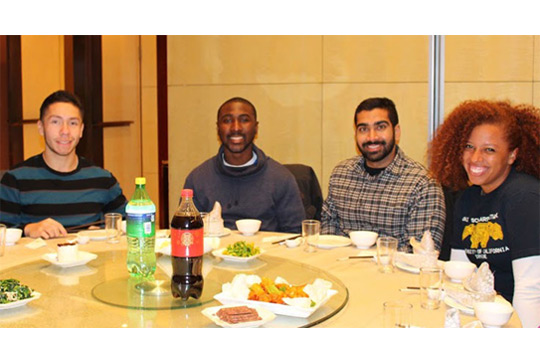 Jan. 11, 2016 -- Engineers hoping to succeed in an increasingly global economy must master more than concepts, theories and skills. They also must learn to work alongside those from other countries and cultures, and it’s in pursuit of this goal that the Samueli School developed an undergraduate collaboration with Peking University.
Jan. 11, 2016 -- Engineers hoping to succeed in an increasingly global economy must master more than concepts, theories and skills. They also must learn to work alongside those from other countries and cultures, and it’s in pursuit of this goal that the Samueli School developed an undergraduate collaboration with Peking University.
A group of three Samueli School students working on their senior capstone project, along with a graduate student recruited to help, is collaborating with a team of students from the Beijing-based university. The mutual goal: to develop triboelectric material that can be placed beneath the tile in subway stations to generate energy from the millions of commuters who trod on them each day.
Now in its second year, this international alliance is led by Farzad Ahmadkhanlou, a Samueli School visiting project scientist, who also serves as a faculty adviser for the Engineering Design in Industry program in the Department of Mechanical and Aerospace Engineering.
Triboelectric energy generation is a relatively new field. Two materials are electrically charged when they interact in one of three ways: sliding, compressing or bending against each other. When a material from a triboelectric series comes into contact in one of these three ways with another material from that series, they generate electricity.
Ahmadkhanlou and the four Samueli School students flew to Beijing last November to meet their teammates at the Chinese research university. Both teams, which had worked independently throughout most of the fall quarter, made presentations and began comparing design scenarios on the project during their four days together. An application design was selected and the students began the project’s next phase: making design modifications that will lead to a working prototype.
“We’re tackling the problems and issues that need to be resolved,” Ahmadkhanlou says. A prototype should be complete by the end of winter quarter. Peking University students will be responsible for some aspects of the final design, while UCI students will oversee others. The prototype will undergo initial testing during spring quarter in the Intelligent Structures and Systems lab directed by Samueli School Dean Gregory Washington.
In late May or early June, the Peking University team will visit Irvine for final testing. At that time, both teams will participate in a design review presentation and will be graded on their efforts.
While presenting logistical challenges, the partnership is expected to prove productive; Peking University has a department devoted specifically to energy harvesting. But perhaps more importantly, the project provides a platform for students to gain experience in international collaboration.
“When they graduate, they may go and work for companies abroad or even in academia, and they need to know how to work together with engineers from other cultures or other countries,” says Ahmadkhanlou. “This is good training for them.”
Electrical engineering graduate student Summer Leone Dumas, who advises the mechanical engineering undergrads on the project’s electrical aspects, also sees the benefit of partnering internationally. “Students will graduate into an interconnected market,” she says, “and learning to communicate and collaborate within this market will allow students to compete worldwide.”
Mechanical engineering major Pavitpal Bhatia, who is on the UCI team, appreciates the exchange of ideas. “Our societies are very different and we went to different schooling systems so it is interesting to see how they think and solve problems,” he says. “We had approached the design in a certain way and they chose a slightly different route. Both parties saw benefits and challenges in the other group’s design, and we agreed on how to resolve this issue.”
Team member Joseph Garcia, also a mechanical engineering student, concurs. “International collaborations allow engineering students like us to see a broader view of design and analytical processes used in engineering. We can view how engineers around the world attempt a problem, giving us the chance to see thinking outside of the … education we have been taught.”
The project is most definitely a proof-of-concept endeavor. The students had to start from scratch: researching triboelectricity, calculating the possible energy-generation potential of the available materials and computing their cost-versus-production ratios. “For some of these pairs of materials, the energy you capture will be low; for some, it will be higher. On the other hand, some of these materials are expensive, while some are not,” Ahmadkhanlou explains. “It’s a tradeoff.”
In addition, the students must design a mechanical device that will generate energy from the chosen materials. The amount of current and voltage produced varies based on whether the device slides, compresses or bends the materials. Another important consideration: manufacturing expenses.
“If the amount of energy you generate is huge but the cost to manufacture is so expensive that you can save money by purchasing a battery, there’s no need to harvest triboelectric energy,” says Ahmadkhanlou.
Regardless of whether the prototype succeeds, participants know they are gaining valuable experience. “I feel we are learning significantly from each other,” says project participant Theron Smith, who adds he is learning from his UCI teammates as well. “The skills and talents that comprise the UCI portion of the team are immeasurable. As we share ideas, and work together we are constantly sharpening each other.”
Bhatia sees impending benefits to the partnership. “Being able to collaborate and learn from each other is an extremely useful skill for our future education, employment and personal goals.”
As for Dumas, she has high praise for her undergraduate teammates. “Meeting and traveling with this group has been a joy,” she says. “They have a great work ethic and are really fun to be around.”
--Anna Lynn Spitzer
